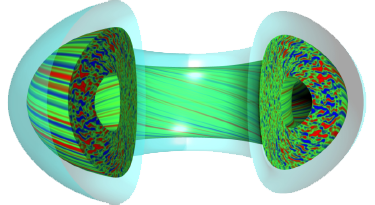Speaker
Description
It is reported about the prior analysis in design and tomography analysis of soft X-ray (SXR) diagnostic on Keda Torus eXperiment (KTX). The tomographic KTX aims at studying three dimensional effect in reversed field pinch with high plasma current, particularly in quasi-single-helicity (QSH) states. In order to reflect the experimental constraints and QSH configuration, the Bayesian experimental design (BED) has been chosen to design the view distribution of the probes. This method can optimize the camera location and emission view angle, aiming at maximizing the gain information in future QSH states equilibrium. The Bayesian tomography method is used to do the following data analysis of SXR. It provides an assessment of reconstruction accuracy of SXR and the uncertainty in the reconstruction from errors can be analyzed by the Bayesian probability theory. The Bayesian principle makes prior and quantified analysis in SXR tomographic and it is expected to be extended to other diagnostics in advanced fusion devices such as ITER.
| Country or International Organisation | China |
|---|---|
| Affiliation | University of Science and Technology of China |

